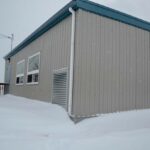
While the summer season is widely known for the big push in road construction projects and housing starts, many workers are also on the job during the winter months. There are dangerous risks unique to working outside in the cold weather that are very different from the typical safety hazards of working outside in the summer. In many cases, winter can be more dangerous than any of the other seasons, especially when it comes to working outdoors.
Winter Construction Site Precautions to Take
Not only is snow and ice a concern, but frostbite, hypothermia, and improper use of heaters pose a big threat to workers’ health and safety. The best way to prevent an accident or injury is to understand the precautions and warning signs.
- Protect hands and fingers with insulated gloves and mittens. Avoid walking with your hands in pockets because it increases the risk of falling on ice and decreases your ability to break the fall.
- Stretch and warm up at the start of a shift. Before performing any heavy lifting or shoveling to reduce risk of injury due to tight muscles.
- Avoid coffee and cigarettes to help your heart’s and blood vessels’ ability to keep your body warm. These things increase heart rate and constrict blood vessels, making the cold weather even harder on your body.
- Invest in thermal and insulated clothing. Coveralls can help reduce core body heat loss while maintaining a good range of motion.
- Wear protective eyewear. Safety goggles will also minimize heat loss and protect your eyes from drying out in the wind and cold air. Pair eyewear with helmet liners and scarves to prevent heat loss from the head and neck.
- Layer up on socks, long-johns, and insulated boots. Steel-toed boots can make toes even colder so make sure to protect them with heavy layers.
- Use portable heating devices. Make sure they are well-ventilated and away from flammable materials. Plastic flaps used to trap heat will also trap noxious gases.
Keep an Eye Out for Winter Weather Hazards
Keep an eye out for common warning signs in yourself and your fellow workers. These include uncontrollable shivering, swollen or puffy face, pale skin, skin that feels unusually firm or waxy, and numbness. It’s important to get someone displaying any of these signs to a warm room as fast as possible and immerse any possibly frostbitten extremities in warm (not hot) water.
Do not walk on frostbitten toes or massage them, as this could cause further damage. Remember that a victim of frostbite do not usually realize it on their own because they cannot feel the frozen tissue. Keep these tips in mind, and stay warm and safe this season!
Contact Satellite Shelters to Improve Your Winter Job Site
Using a Satellite Shelters mobile office trailer lets you keep your projects on track. Don’t let winter slow down your construction projects! Satellite Shelters’ mobile offices for sale will give your crew a warm, weather-protected space, perfect for working in any season. Contact us via email today to get started! Rent or buy our strong, insulated trailers year-round to help you stay organized, comfortable, and productive.



